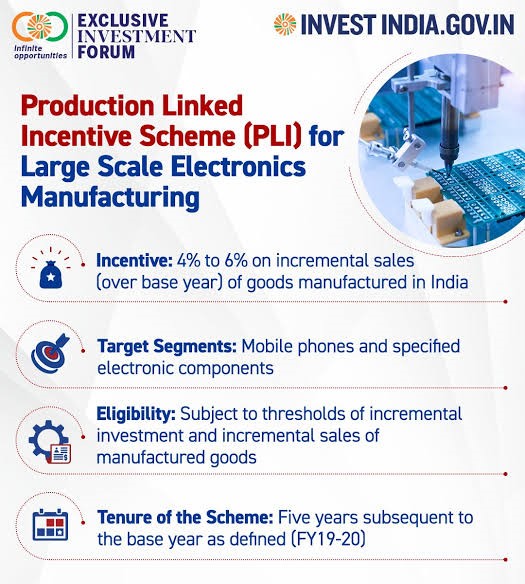Why in news?
The Union Cabinet recently approved the Production Linked Incentive (PLI) Scheme for specialty steel with an outlay of Rs 6,322-crore.
What is the PLI scheme?
- For target segments, the scheme provides incentive of 4% to 6% on incremental sales over the base year for goods manufactured in India.
- Apart from inviting foreign companies to set shop in India, it encourages local companies to set up (or expand existing) manufacturing units.
- The scheme came in line with the National Policy on Electronics 2019 to position India as a global hub for Electronics System Design and Manufacturing (ESDM).
- Objectives:
- Encourage local production
- Reduce India’s dependency on imports and cut the import bill
- Boost export earnings
- Increase the share of manufacturing to 20% by 2025.
Manufacturing as a share of India’s GDP fell to 15.6% in FY20 and stayed there in FY21, down from the high of 16.8% in FY18.

How is the performance so far?
- The progress of the PLI scheme has been somewhat slow.
- Of the 13 sectors for which outlays have been finalised, guidelines need to be framed for a few.
- In others, the industry’s concerns need to be addressed.
- For textile products and automobiles, the schemes are awaiting Cabinet approval.
- But the auto sector hugely relies on imports for a range of components and is one of the country’s biggest employers.
What is the recent PLI scheme for speciality steel?
‘Specialty steel’ is a downstream, value-added product of steel manufacturing process. However, there is no universal definition of ‘specialty steel’.
- The PLI incentive is expected to boost the domestic production of specialty steel by -
- attracting significant investment
- infusing technology and know-how
- promoting exports
- It will apply for the following 5 indicative product categories:
- Coated/Plated Steel Products
- High Strength/ Wear resistant Steel
- Specialty Rails
- Alloy Steel Products and Steel wires
- Electrical Steel
What is the rationale?
India is one of the largest steel producers in the world, with production numbers of 102 million tonnes in FY21.
- There is a huge gap in India between the production of steel and value-added steel i.e., speciality steel.
- But speciality steel has various strategic applications like defence, space, power, etc.
- So, there is a reliance on imports leading to heavy forex outflow given the higher average price per tonne for speciality steel.
- To address this, the direct fiscal incentives in the form of ‘PLI’ aims to boost manufacturing of speciality steel in India.
- Applicants have also been given the flexibility to avail other Central and State incentives alongside the PLI scheme for their investments.
Expected outcome
- Increase production of speciality steel by 140% by FY27, over the baseline period of FY20.
- Reduced import dependence to the tune of 76%
- Increase in exports by 244%
- Compete with Korea and Japan leading in the sector
What lies ahead?
- For the PLI scheme to work in all the 13 sectors identified, the government must work harder to satisfy the manufacturers’ needs.
- The PLI outlay must deliver returns in the form of jobs and worthwhile import substitution, enabling the economy to become part of some global supply-chains.
Source: Business Line, Financial Express, PIB
